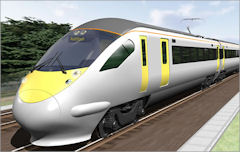Thomas R. Frantz, CEO of the Williams Mullen law firm and board member of the Virginians for High Speed Rail, paints a picture to Times-Dispatch reporter Michael Martz of what it would be like if Virginia had good inter-city rail connections. He imagines riding The Tide light rail line from his law office in Virginia Beach to Norfolk’s Harbor Park, where he could catch a train to Main Street Station in Richmond. From there, it would be a walk of several blocks to the law firm’s headquarters building.
Undoubtedly, many other people would like the same convenience. I, for one, would enjoy taking the train to Norfolk to visit my parents, who live one block from The Tide’s terminus in downtown Norfolk. My family also likes to travel to Washington, D.C., and, less frequently, New York, and it is nice to dispense with the car on such trips. Moreover, I think it makes far more sense to locate an inter-city rail station in downtown Richmond rather than a dismal commercial strip on Staples Mill Road in Henrico County.
Yes, inter-city rail to downtown Richmond would be nice. But would Mr. Frantz be willing to pay what it costs to cover the up-front capital improvements — estimated at $300 million by City of Richmond officials and $600 million by Department of Rail and Public Transportation Director Thelma Drake — as well as the operating costs for the rail service? Martz doesn’t tell us what the cost of subsidized versus un-subsidized ticket would be. If the ticket price for the Richmond-to-Norfolk trip went much higher than $50 per person, I’d just as soon take my family in a car.
High-speed inter-city rail is one of those ideas that sounds great when somebody else is paying for it but not so great if you have to pay the full cost yourself. Moreover, unlike rail transit, where stations create significant wealth for neighboring landowners that can be tapped to help cover the capital costs, real estate developers don’t appear to be willing to pay a premium to locate near inter-city rail stations.
Remarkably, government and civic leaders in the Richmond region have elevated inter-city rail to the top of their list of regional priorities, even though there is no chance that the state can find the money and next-to-no chance that the feds will cough it up.
Former City Council President Bill Pantele sums up the case for the high-speed rail lobby, “It’s good for the public. It’s good for the economy. It’s good for the environment.” I like Bill, and I think he was a good City Council president, but I have to ask an impertinent question: Inter-city rail may be good for everyone if it were free, but how good can it be — how much economic value is it creating — if ticket sales cover only a tenth or a fifth of the full cost (not just the operating cost) of providing the service? That sounds like it would be bad for the economy.
Now, the inter-city rail enthusiasts have one good come-back. The commonwealth is subsidizing roads and highways, why not inter-city rail? That’s very true. Once upon a time, it could be said that roads and highways paid their own way through the motor fuels tax. But a reluctance to raise the highly visible gas tax has prompted politicians to subsidize roads by means of a wide range of taxes. Most of those taxes are automobile-related — taxes on the sale of vehicles, taxes on drivers licenses — but they have been supplemented increasingly in recent years by the General Fund and other sources.
The pro-rail lobby also can argue that rail has fewer externalities, or spillover costs incurred by society. I agree that there is a value to curtailing gasoline/aviation fuel consumption, reducing imports of foreign oil and cutting the resulting pollution.
It strikes me, however, that the debate over high-speed rail specifically, and transportation policy generally, is totally incoherent. First, so many costs are diffused, hidden or hard to calculate that no one knows the true cost of anything. Second, there is absolutely no effort by anyone (other than the lone crusader, Fairfax Del. Jim LeMunyon) to prioritize transportation projects by Return on Investment. Without an impartial methodology for ranking transportation projects by ROI, there simply can be no intelligent conversation. In an analytical vacuum, capital funding will be allocated on the basis of special interest politics and log-rolling with a bias toward high-visibility projects that generate headlines, if not passengers.
And third, there is no acknowledgment of transportation alternatives, such as the burgeoning inter-city bus industry. How much would a bus company charge to convey Mr. Frantz from Virginia Beach directly to downtown Richmond in accommodations as commodious as a train — without public subsidies of any kind? If no such service currently exists, what does that say about the size and viability of the market for that service?
Bacon’s Rebellion — asking the questions no one else dares ask.



